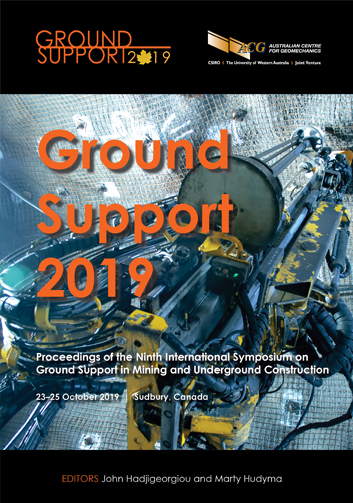Ground support installation quality controls and possible pitfalls: a case study from a critical fall of ground contract rehabilitation project

|
Authors: Viljoen, BN; Murphy, BA |
DOI https://doi.org/10.36487/ACG_rep/1925_42_Viljoen
Cite As:
Viljoen, BN & Murphy, BA 2019, 'Ground support installation quality controls and possible pitfalls: a case study from a critical fall of ground contract rehabilitation project', in J Hadjigeorgiou & M Hudyma (eds), Ground Support 2019: Proceedings of the Ninth International Symposium on Ground Support in Mining and Underground Construction, Australian Centre for Geomechanics, Perth, pp. 581-592, https://doi.org/10.36487/ACG_rep/1925_42_Viljoen
Abstract:
Ground support installation in underground mines is a routine task that is performed daily to maintain a stable excavation and safe working environment. The ground support design is usually specified in terms of the support type, capacity, dimensions and pattern of ground support while the support capacity is based on manufacturer’s specifications and some trials. In other cases, support standards from similar operations are adopted and assumed to fulfil the intended purpose. Once the support design is implemented, it is not unusual that the process becomes ‘business as usual’ and less attention is paid to the controls required to achieve the designed support capacity. This is likely more prevalent in shorter-term contract applications that have changing teams and variable equipment usage. A recent project demonstrates how ongoing extensive testing and routine quality control was instrumental in identifying problems with the support product selection, equipment setup, and installation procedure. Support product selection based on supplier’s specification with limited consideration of other factors proved to be, in some cases, a fatal flaw. Support installation/application and implementation procedures adopted from similar operations provide a reference point, but site-specific implementation must consider potential differences, such as variations in the installation equipment, rock mass conditions, and support products. These factors must be assessed and resulting processes must be verified before implementation of a support design. This paper presents a case study to illustrate potential pitfalls when adopting the ‘standard approach’ and the value of support trials, routine testing, and the need for continuous quality assurance, especially for shorter-duration contract projects.
Keywords: ground support, testing, implementation, quality control, quality assurance
References:
O’Toole, D & Pope, S 2006, ‘Design, testing and implementation of “in-cycle” shotcrete in the northern 3500 orebody’, in DR Morgan & HW Parker (eds), Proceedings of the 10th International Conference on Shotcrete for Underground Support, American Society of Civil Engineers, Reston.
Hilti 2011, Determination of the early strength of sprayed concrete with Hilti DX 450-SCT - Operating Instructions, Schaan.
ASTM International 2018, Standard Test Method for Obtaining and Testing Drilled Cores and Sawed Beams of Concrete (ASTM C42/C42M-18a), ASTM International, West Conshohocken.
© Copyright 2025, Australian Centre for Geomechanics (ACG), The University of Western Australia. All rights reserved.
View copyright/legal information
Please direct any queries or error reports to repository-acg@uwa.edu.au
View copyright/legal information
Please direct any queries or error reports to repository-acg@uwa.edu.au